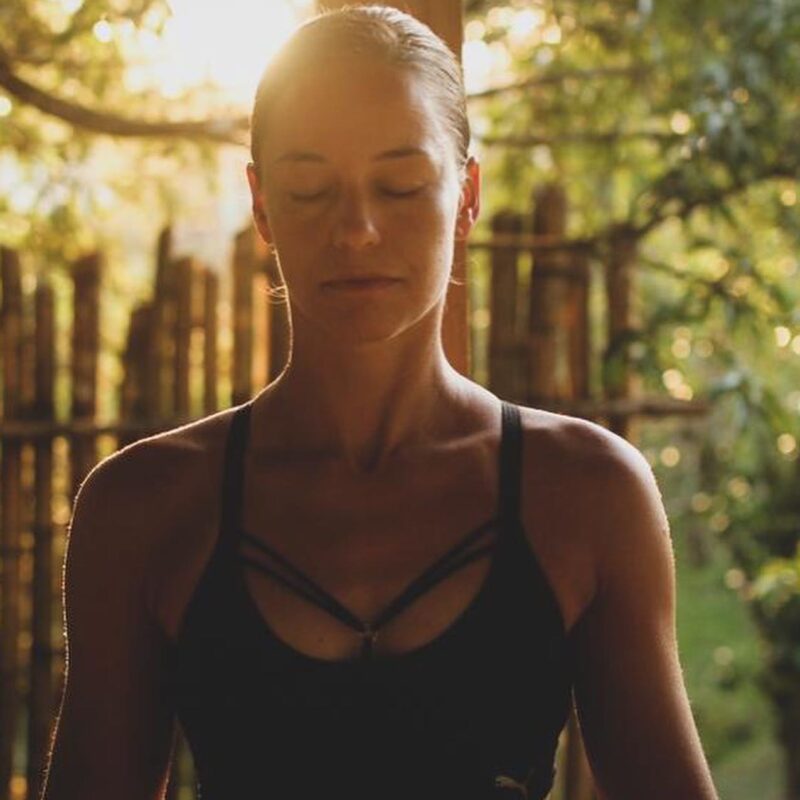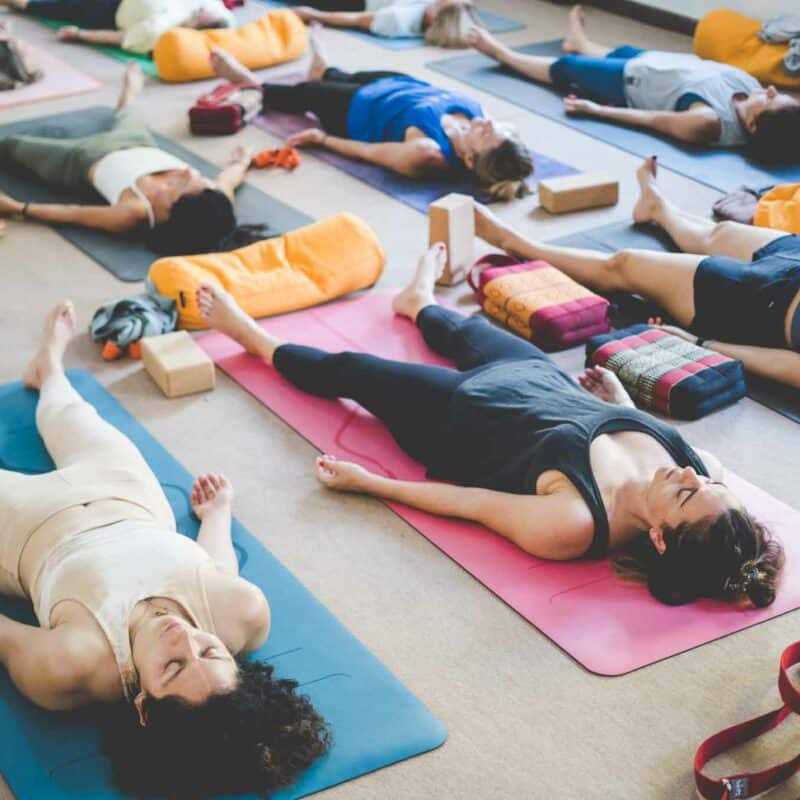My Connection to My Yoga Practice
Yoga is the martial art of the soul, and the opponent is the strongest you’ve ever faced – your ego
Over the years, my connection to my yoga practice has constantly evolved.
In my late teens, I resolved to graduate with top marks in my psychological research degree at university. In those days, my schedule planner looked like a train wreck of scribbles as I attempted to hammer out twelve-hour study days. Any social life I had at the time went down the drain.
I would wake up before the sun each morning, and drive 15 minutes through my sleepy little university town to hit my bikram studio for my yoga practice. My yoga practice kept me sane. It was the only time in the day I could be still and put my busy schedule on hold for 90 minutes; the only time in the day I could move my body – spending the rest of my day sitting at a desk in the library. My yoga practice was the only place I practiced self love, and it was the very thing that taught me the discipline and sense of gratitude that has helped me to accomplish some of my most proudest achievements.
After graduation, I began to run half marathons, and in 2014 ran a full marathon while undertaking a masters degree at a medical school in the centre of bustling London. Life was busy, to say the least. During my running training, I remember having a fitness coach tell me, “Push. Harder than you want to. Further than you think you can.”
I cringe reading these words now – these days, I know that trying to overpower your body and mind with brute force is a dangerous game and am much more a fan of honouring where I’m at with compassion when I’m at my worst, and gratitude when I’m at my best. But in those days these words resonated with my very being. In those days, my yoga practice served me physically as a cross-training tool for my running game, but it was more than that. Words cannot describe the feeling of laying down in a final meditation after pushing my body and mind physically harder than I could stand for months at a time.
At the same time, I began to study and become involved in mindfulness based psychotherapy, and became heavily interested in the parallels between the eastern philosophical principles on which yoga is based, my own academic studies in mindfulness based psychology, and personal realisations coming from my own inner growth.
My yoga pra
A Turning Point
Then one day, my ability to bounce out of bed in the morning at the sound of a 5:30 alarm came to a screeching halt. To put it shortly, I began a slow decent – losing motivation in all areas of my life. After all of this forcing, my mind and my body began to shut down. It seemed that all along, they had been asking me to take a break, and I hadn’t been present enough to allow for that. Looking back, I now know that I was afraid that if I paused, I would lose everything…
Well, I did pause, and I did feel like I lost everything (including, to my dismay, my connection to my yoga practice). I was lost in the dark. My yoga practice that had been shining the light for me, leading the way felt like it had betrayed me. I lost all motivation to attend classes; my yoga practice was non-existent. When I did get myself to go to class, my body and mind became a source of frustration. I began to carry extra weight around my body – the result of taxed adrenal glands pumping out too much cortisol. My usually sunny disposition was replaced with exhaustion and lethargy.
I was suffering from burn out. I stopped feeling like me.
And I think this is something many, many people these days (women and men included) experience in a society that tells us what success looks like, but never explicitly talks about what success should feel like. It’s assumed that if you’ve got all of the right roles, labels, medals, grades, the right partner, the right body, the right things – you’ll feel golden on the inside.
Rising Strong
It’s been about a year and a half, and I’m coming out the other side now. I’ve learned the difference between forcing my life to fit the “success mold”, and aligning with my higher self/letting go/allowing life to take me where it may – trusting that it has my best interests at heart, even when it hurts like hell.
I’ve come to terms with the feelings of insecurity and fear that had me hustling for my own self worth in those years.
I now know deeply that I am enough, exactly as I am. And while I’m still proud of my accomplishments, I no longer feel that I need to run 42.2 km in one go to prove my worth.
I’m now a yoga instructor, and my connection to my yoga practice has never served me in a more powerful, spiritual, uplifting and life changing way. But it took going through a long period of feeling disconnected – with myself, my loved ones, my body, and my yoga practice to return stronger and better for it.
It’s not uncommon. It happens all the time.
We forget who we are, so that we can go through the beautiful process of remembering again.
It is said our yoga practice makes us face ourselves, and in line with this view, I personally see my yoga practice as an extension of my connection to myself. When my connection to my yoga practice suffers, I know something is up with my own relationship with myself. It’s time to turn inward.
Here are my reflections of what has helped me reground in my connection to myself and to my yoga practice. This is about getting back up.
1. Arrive where you are.
It seems obvious and simple, but it is surprisingly rare. We are hardwired to avoid the present moment (anybody who has tried meditation can attest to this!), and this is the ultimate challenge.
This is the starting point. You’ve got to name it to tame it. Take inventory of exactly where you are. Instead of avoiding the negative feelings that this brings up, go into them – go into them completely.
How does it feel to be you in this moment? I would even suggest lying down on the floor, and letting your emotions wash over you entirely. I did this every day for about 4 months. You may cry every day. You may think that it will never be over; you may doubt having ever allowed these feelings to take you over in the first place.
Then one day, you’ll notice that you’re out the other side. The emotions are dealt with, through and through. You’re okay again. And you’re stronger and wiser for it.
It was especially important for me to do this, because my go-go-go lifestyle had me doing so much, I had no space to be. It meant that in all of those years, my emotions went unprocessed, and in allowing myself to feel them, they hit me like a ton of bricks. And that was exactly what I really needed at the time.
Acceptance is transcendence. The only way out is through.
2. Identify your values.
Acceptance and Commitment Therapy (ACT – a mindfulness focused form of cognitive behavioral therapy) talks about there being a huge difference between being lead by your goals, and being lead by your values. ACT expert Russ Harris (Australia) explains wonderfully here:
We may not always have control over whether or not our goals are being achieved, and achieving our goals may not always satisfy us the way we believe they will.
For example, we may have the goal of doing a yoga practice seven times per week, but wake up completely exhausted. And we can’t change that – we can’t choose the way that we feel. In fact, the more we try and control and banish our negative feelings, the more they tend to come back stronger (this is in line with arriving where you are).
However, we can choose to act in line with our values at any given moment. We can choose to react to doubt, insecurity, feelings of emptiness or lack, fear, or exhaustion with compassion and self-love.
For me, my body was begging me not to push it through another 90 minute bikram class, but when I skipped out on the class I would be overcome with guilt – my self esteem would plummet, because I was used to a high level achievement.
So I wasn’t achieving the “goal” I had set out for myself. But then I began to ask myself, what is it about yoga that I really value?
To understand this process, think about a yogi who truly and deeply inspires you. Think not about what they do, but about the ways of being that underlie their life choices. What do they stand for? What personality characteristics make you value them?
What is about them that you find inspirational? Here is where you can find your values.
Once you find your values, you will realise that there are a million and one ways to act out these values, even if you’re not achieving your goal.
Do you value deep knowledge? Instead of going to class, read a book about something you really care about, or take a class in eastern philosophy. Grow your yoga practice in other ways.
Do you value the spirituality? Take time to form a consistent meditation practice.
Do you value the physicality of your yoga practice? Take 10 minutes out of your morning to put your feet up the wall in viparita karani. Taking that small piece of time for self care will still leave you feeling invigorated and grounded.
Your mind, and your yoga practice, will thank you.
Either the goal of yoga practice is to be free, or the goal of yoga practice is to get it right. You can’t really have it both ways. Because if you choose freedom, you have to divest yourself of that crazy idea that you have to get it right.
3. Identify what underlying thoughts and emotions are stopping you from acting in line with your values.
Getting back up is a spiritual experience in that to stop yourself mid-fall, you must disengage from the negative spirals of words and feelings that propel you further downward. The realisation that you are not your thoughts or your feelings helps lead us to what we really are – the non-judgmental awareness, or the observer of those thoughts and feelings.
This is the very philosophy that underlies the spirituality of a yoga practice. We observe the discomfort in our minds and bodies that arise in the context of the asanas, so that we can observe them, disengage from them, and find our true selves.
4. I’m having the thought that ….
An ACT exercise I found very helpful in identifying and disengaging from my negative self talk was this short little exercise:
Whenever you notice that you are getting caught up in negative downward spirals of thoughts, take a moment to “press the pause button”.
Identify the thought that is coming up.
Say to yourself, “I’m having the thought that… I can’t muster up the energy to do a yoga practice today.”
Or better yet, “I notice… I’m having the thought that… I can’t muster up the energy to do a yoga practice today.”
This space between observing and the thought is key. When we can stop identifying with our thoughts, they lose their power to take us over and become us. From this place, we have the space to choose how we will respond to the automatic and habitual patterns of our mind. This space is the key to finding liberation from those patterns.
5. Committed action:
To put it all together, the key to coming back to ourselves (and thus, our yoga practice) is to:
a) accept the pain that often accompanies those automatic and often uncontrollable negative emotions and thoughts that come up for you with a sense of compassion, openness, and curiousity
b) create enough mental space to learn how to choose how, deep in our hearts, we would like to respond to them. Reflect on what you would like this period of your life to stand for when you look back on it.
These two concepts are not separate from one another. Pain and values are two sides of the same coin.
In any given moment of discomfort, fear, pain, doubt, insecurity, or lethargy, we have two choices. We can avoid the pain by pretending it’s not there, by lashing out at ourselves or others, or covering it up with intoxicating substances or busyness… thus, moving ourselves away from our values.
Or, we can accept our painful feelings and thoughts, with the knowledge that they are transitory – with the knowledge that they are trying to teach us something important. We can hold compassion for ourselves and treat ourselves well. We can invite radical presence into our lives, inviting the pain in, being open to what lessons it is trying to teach us, while we move towards our values. This is the path to creating meaning, growth and purpose out of a period of difficulty.
6. Heal your body:
Even when I had done all of the mental and emotional work to heal myself, my body still held onto what I had put it through. Find a way to care for your body. Learn to cook nourishing foods that aid your body in healing. Exercise in whatever way makes you happy that day. I had to cut out coffee and stimulants to try and heal my adrenal glands. I got acupuncture, and lots of massages. I experimented with essential oils, which I found to be hugely helpful in grounding me, helping me breathe, and pulling me into the present moment. I created a solid meditation routine. I made a shrine in my home garden, and devoted mornings to a more yin based yoga practice, and just sitting in the sunshine, remembering the joy of just being.
Coming back to your yoga practice
This process may last a week, a month, a year, or years depending on how long you have been putting it off. My final piece of advice has no scientific basis, only my own experience to back it up.
Trust the process. There is something in this period of your life that is trying to present itself to you, preparing you for a greater future.
What you seek is seeking you
Open yourself to your experiences. Each experience, whether painful or beautiful, contains microscopic bits of information about what the universe is trying to tell you. You are in this place, at this very moment in time, for a reason. Ground down and feel it.
Sadness gives depth. Happiness gives height. Sadness gives roots. Happiness gives branches. Happiness is like a tree going into the sky, and sadness is like the roots going down into the womb of the earth. Both are needed, and the higher a tree goes, the deeper it goes, simultaneously. The bigger the tree, the bigger will be its roots. In fact, it is always in proportion. That’s its balance.



